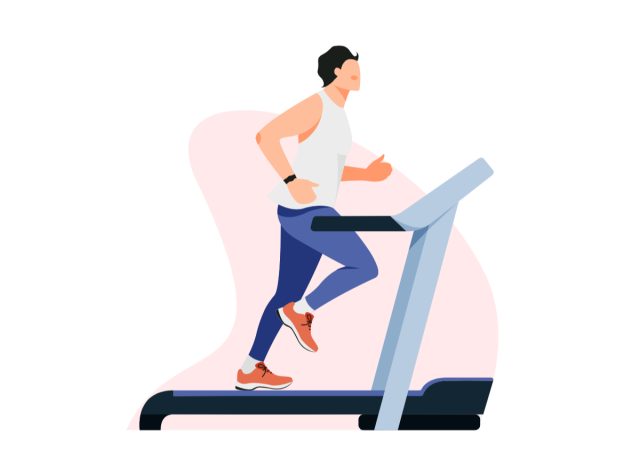10 Best Strength Exercises To Do on the Treadmill

If you're under the impression that treadmills are solely for cardio workouts, think again! While they're fantastic for increasing your heart rate and torching calories, treadmills can also be your secret weapon for building strength. With a bit of creativity and a willingness to break away from the norm, you can transform your treadmill into a versatile piece of strength training equipment. Gear up, because in this guide, I'll share the low-down on my 10 of the best strength exercises to do on a treadmill.
These exercises are not only great for building muscle and enhancing strength but also add an element of fun and variety to your workouts. From walking lunges and squats to farmer carries and sled pushes, these workouts will maximize your strength gains. Whether you're a seasoned gym-goer looking to shake things up or a treadmill newbie eager to optimize your time, these moves will help you get stronger, fitter, and more excited about your treadmill sessions.
Treadmill Lunges
Treadmill lunges are excellent for targeting your quads, hamstrings, and glutes. They also engage your core for stability, making them a fantastic compound exercise. Performing lunges on a moving treadmill adds an extra balance challenge, which helps improve coordination and increases the engagement of stabilizing muscles around the knee and ankle joints.
Set the treadmill to a slow speed, around 1 to 2 mph. Step forward with your right foot and lower into a lunge, ensuring your knee doesn't go past your toes. Push back up to the starting position, then step forward with your left foot into the next lunge. Keep your core engaged and maintain an upright posture throughout.
Aim for three sets of 12 to 15 lunges on each leg. If you're new to this, start with a shorter duration, like one minute per set, and gradually increase as you get stronger.
Treadmill Incline Walks
Incline walks are a fantastic way to add intensity without pounding your joints. Cranking up the incline engages your glutes, hamstrings, and calves more than on flat ground. Plus, your heart rate gets a nice boost, making it a great mix of strength and cardio. It's perfect for those days when you want a solid workout but aren't in the mood for running.
Set the treadmill to an incline of 5% to 10% and a moderate speed (2.5 to 3.5 mph). Walk steadily, ensuring you maintain good posture with your core engaged and shoulders relaxed.
Aim for three sets of five to 10 minutes each. Adjust the incline and speed based on your fitness level and goals.
Side Shuffles
Side shuffles are fantastic for working your inner and outer thighs and glutes. They also provide an excellent cardiovascular workout, boosting your heart rate while building lower-body strength.
Set the treadmill to a low speed, around 1.5 to 2 mph. Turn to your side and start shuffling your feet, staying light on your toes. Keep your knees slightly bent and your core engaged. Switch sides after completing your reps or time.
Perform three sets of one to two minutes per side. Increase the duration as you become more comfortable with the movement.
Treadmill Sled Push
This exercise mimics a sled push and targets your legs and glutes. You'll feel like you're pushing a heavy sled, even without the extra weight. It's incredible for building explosive power and increasing your heart rate—perfect for those high-intensity workout days.
Set the treadmill to a low speed and incline. Place your hands on the front handles and lean forward into a running position. Drive your legs against the moving belt, simulating the action of pushing a heavy sled.
Perform three sets of 30 to 45 seconds. Focus on maintaining high intensity throughout each set.
Treadmill Squats
Squats on a treadmill target the quads, hamstrings, glutes, and core, fortifying your strength via compound exercise. The moving belt adds an extra balance challenge, making your muscles work harder. This exercise also improves functional strength, enhancing your performance in daily activities and other workouts. Continuous movement can increase muscle endurance and promote better balance and coordination.
Set the treadmill to a low speed (0.5 to 1 mph). Stand sideways, squat as low as possible, then push back up. Switch sides after completing your reps or time.
Perform three sets of 12 to 15 reps on each side. Focus on maintaining balance and proper form throughout.
Treadmill Walking Lunges
Walking lunges are a potent lower-body move. They target your quads, hamstrings, and glutes while challenging your balance and stability. Doing them on a treadmill adds new difficulty and keeps things interesting. Plus, they're great for improving hip flexibility and overall leg strength.
Set the treadmill to a slow speed. Take a large step forward with one foot, lowering your body into a lunge. Push through your front heel to bring your feet together, then step forward with the other foot into the next lunge.
Aim for three sets of 10 to 12 lunges per leg. Adjust the speed based on your comfort and balance.
Treadmill Heel Walks
Heel walks on the treadmill are a fantastic way to strengthen the tibialis anterior, the muscle running along the front of your shin. They're awesome for improving balance and ankle stability, and they're especially great if you're looking to prevent shin splints. Plus, heel walks can help improve your gait and reduce the risk of lower leg injuries.
Set the treadmill to a slow speed. Walk on your heels with your toes pointed upward, keeping your legs straight and core engaged. Focus on maintaining balance and controlled movement.
Perform three sets of one to two minutes. You can add treadmill heel walks to your warm-up or cooldown routine.
Treadmill Sprint Intervals

Sprint intervals on a treadmill are high-intensity exercises that boost cardiovascular fitness and build explosive leg strength. This workout enhances your anaerobic capacity and helps you torch calories rapidly. It also improves your speed and endurance and seriously boosts your metabolism.
Warm up with a light jog for five to 10 minutes. Increase the treadmill speed to a challenging sprint and run for 10 to 20 seconds. Reduce the speed to a slow walk for one to two minutes to recover. Repeat the cycle.
Perform six to 10 intervals. Adjust the sprint and recovery durations based on your fitness level and goals.
Treadmill Farmer's Carry
Talk about multitasking! The farmer's carry on the treadmill not only works your legs but also gives your arms, shoulders, and grip a serious workout. It's like carrying heavy grocery bags but way more fun and controlled. This exercise is great for building overall strength and stability, making everyday tasks more effortless.
Grab a pair of dumbbells or kettlebells and set the treadmill to a slow speed (1 to 2 mph). Hold the weights at your sides with your arms straight, keeping your shoulders back and your core engaged. Walk steadily, maintaining good posture throughout.
Aim for three sets of one to two minutes each. Gradually increase the weight and duration as your strength improves.
Treadmill Walking Bicep Curls
Combining walking with bicep curls is a great way to sneak in upper-body strength training while getting your steps in. This move targets your biceps and improves coordination since you're multitasking. It's perfect for those who want to maximize their workout time and get more done in less time.
Grab a pair of light to moderate dumbbells and set the treadmill to a slow walking speed (1 to 2 mph). As you walk, perform bicep curls by bending your elbows and lifting the weights toward your shoulders, then lowering them back down in a controlled manner. Ensure you maintain good posture and keep your core engaged throughout the exercise.
Perform three sets of 12 to 15 curls per arm. Adjust the weight and duration based on your strength and comfort level.









